When I was a kid, my dad lived in New York City. My sister and I would come to stay with him every other weekend. When my parents divorced, my dad made a career change too, from the garment industry to Manhattan real estate. In the ’80s, he did what was known as apartment swapping. Meaning, he’d buy a place, fix it up and then sell it or swap it for something better. Usually with the furniture involved, so as kids, it felt like every few months or so, we were living some place new, with somebody else’s things.
During the day, my dad had a short list of places he would take us— Lox Around the Clock (now closed), the Cabbage Patch Kid Hospital (now closed), the Marriott Hotel in Times Square (brand new at the time; my sister and I loved riding up and down the glass elevators and eating at the revolving restaurant on top) and the Twin Towers. We loved going to the Observatory Deck and seeing what Manhattan looked like from the highest perch possible. We went at night too, when it looked like the city lights below stretched farther than you could see.
After a few years of apartment swapping, my dad settled into an apartment in the West Village with a wall-to-wall, floor-to-ceiling window looking South. The window perfectly framed the Twin Towers, so for years, they were something I always associated with my dad.
Years later, when the towers collapsed, my dad was the person I sought out and spent the day with; stunned, helpless and watching the news. Behind us, that same window, with a view of an empty space where the towers used to be. (You can read more about my experience on 9/11 here.)
When the plans for One World Trade came out, it was presented in the NY Post as a competition, with various designs by different architects. I remember my dad and I looking through the pictures over breakfast (we’d often get together in the morning), assessing which design we liked best.
It took years before the new One World Trade finally materialized. I have a view of it outside my bedroom window, so I’ve watched as the structure went up, stalled and then was finally completed, looking very different than any of those initial plans.
It took even longer for me to go back and visit. When it first went up, the thought of entering the building and going to the top felt like you were taking a risk. I couldn’t imagine making a decision to work there every day.
This year, a full 17 years after 9/11, it finally felt like enough time had passed. I suddenly had the urge to go up to the top of One World Trade and take my kids. I wanted to show them this unique perspective of our city. It might be a different building, but the view would be the same I remember experiencing when I was little.
During spring break a few weeks ago, we had a free day and I decided to take them. I went online to purchase tickets and I got a phone call.
“You picked up!” It was my dad. His biggest complaint is that I never answer his calls. “What are you doing tomorrow?”
“I’m actually taking the girls to the top of One World Trade tomorrow. Have you been yet?”
“No.” He had not.
“Do you want to come? I’m about to buy tickets.”
“Yes,” he said. He would.
The next day we all stood at the bottom of the building, Mazzy and Harlow marveling about how they could barely crane their necks to see the top. Just like my sister and I used to say so many years ago.
I was a little concerned about what would happen once we entered the building. Was there any reference to the towers falling? What would Mazzy and Harlow think of all the security? But they didn’t really think twice about it, except to say that it reminded them of an airport. There is also no reference to 9/11 in the building that we saw. They keep it very positive and looking towards the future. The memorial is outside and the 9/11 museum too, but if you want to save that for another day or for when your kids are older, you can go to the top and just appreciate the view.
The elevators were probably Mazzy and Harlow’s favorite part. The interior is covered with video screens and as you ascend, they show the New York City landscape before there was even a single building built, something Mazzy is learning a lot about in school. As the elevator rises, you begin to see structures rise as well, and by the time you get to the top (floor 102), present day Manhattan is fully on view.
The elevator lets you out into a long narrow hallway, where video screens line one side. Everyone is instructed to turn and watch the video, which shows the energy of NYC and everything that is unique about the different neighborhoods. By the time the tenements rose on the Lower East Side, I had a knot in my throat and was trying not to cry. I looked at my dad and saw he was in the same place.
At the end of the movie, the screens lift and reveal the windows behind them, where you could see the entire Southern view of Manhattan sprawled before you.
“Look! There’s the Statue of Liberty!” Mazzy pointed. “It’s so tiny!”
“I bet we can see the Empire State Building from here!” Harlow said.
They have touchscreens to rent, which my dad got for the girls. On them, you can see an identical view to the one outside (it changes depending on where you are standing), which lets you select specific buildings to learn more about them.
They seemed tough to navigate to me but Mazzy was able to do it just fine. She even found our apartment building, first in real life and then confirmed it on the touchscreen.
There is not much to do at the top of One World Trade except look at the view, so I let Mazzy and Harlow run around for a bit while my dad and I talked about how much had changed and how much had stayed the same since we were last standing together on top of Manhattan.
There’s something very pristine and airy about the interior space that feels very different than the dark steel structure I remember from the ’80s. Meanwhile, the girls laughed, refused to stand still for photos and circled the space, getting a big kick out of ending exactly where they began.
They didn’t detect any danger, of course, or see any larger significance.
Just the magnificence of their city, laid out before them, as always.





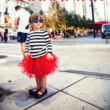


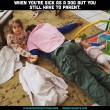




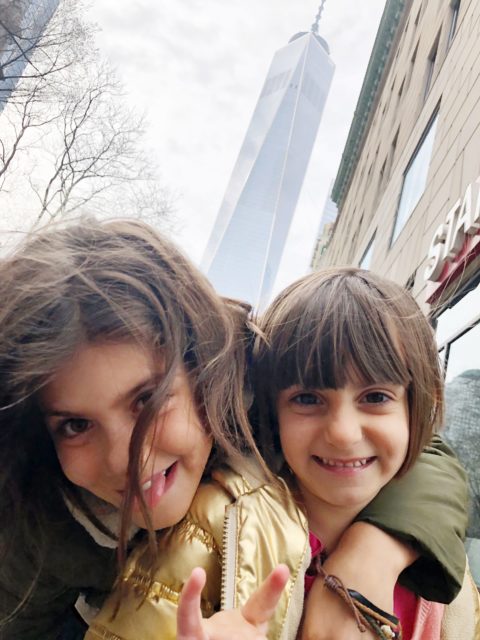
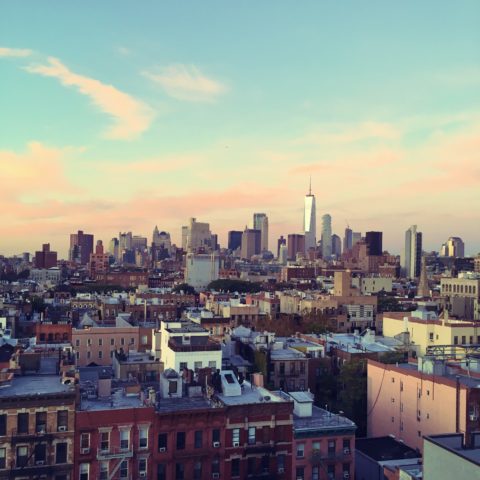
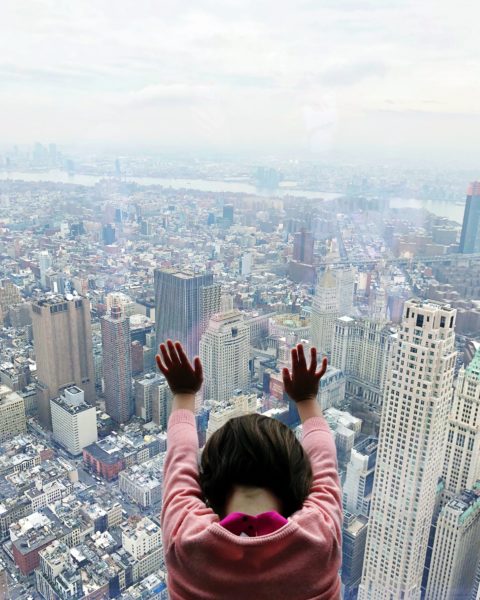
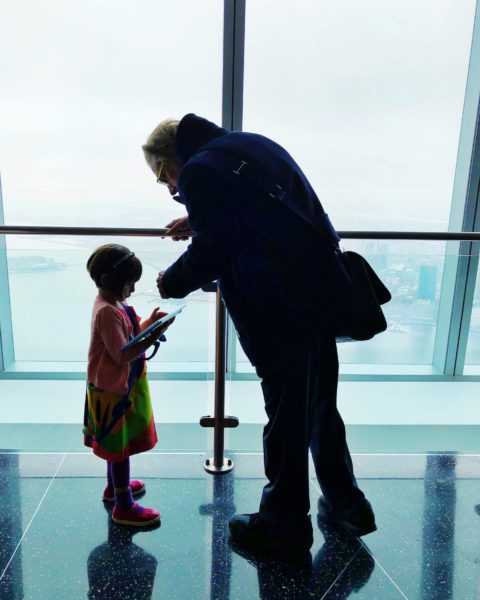
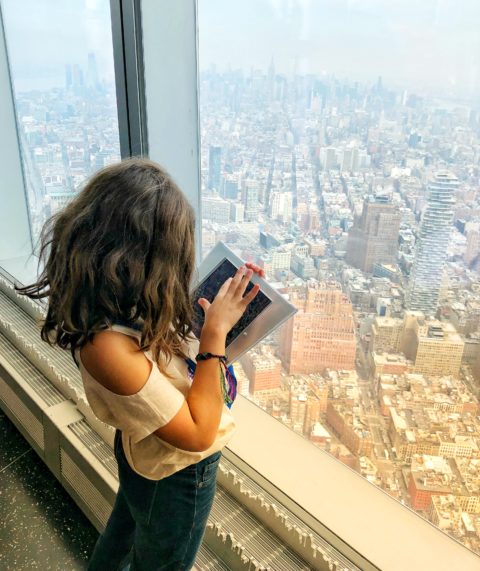
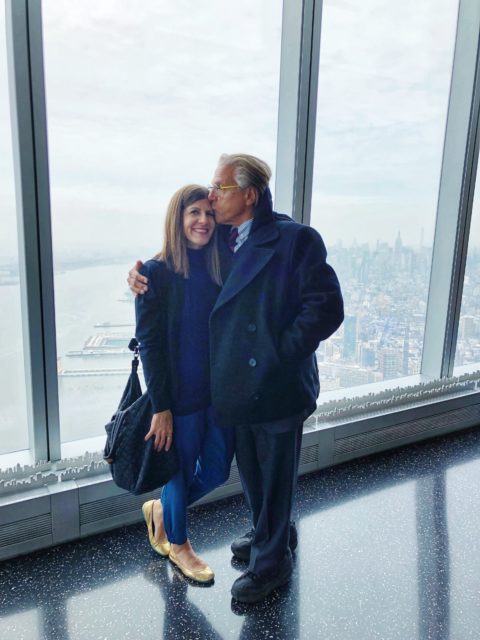
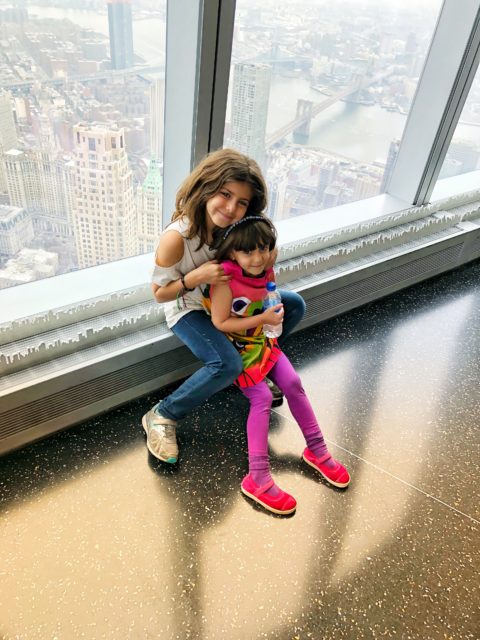
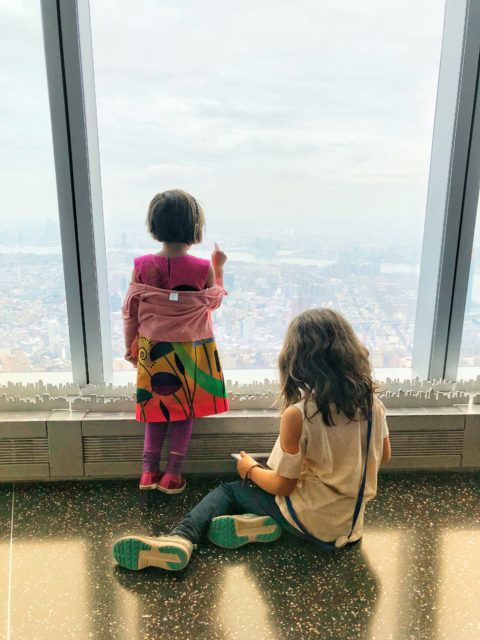

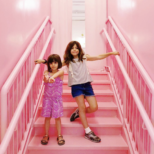
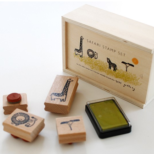
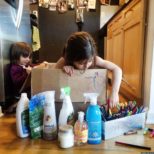

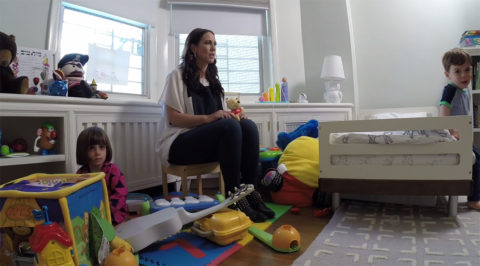






I really enjoyed this post. I love your typical funny and light-hearted posts but I am especially loving the more serious posts you are occasionally posting as of late!
Beautifully written and so poignant!
I grew up in PA, my first time in NYC as a kid I went to the restaurant at top of the World Trade to be amazed by the view. I moved to the west coast after college and the last time I was in NYC before 2001, I very clearly remember looking back at the city one last time driving away and seeing the Twin Towers. I was pregnant with my first on 9/11. I remember in all the feelings the thought “I cannot believe I will have to explain this to my child someday. How does one explain this?” I have not been inside the tower yet, but I have been to the memorial. Heartbreaking. We were back on the east coast and in NYC over Christmas last year. As we drove back to PA, my last look back was of the Freedom Tower. Great post, the pic of you and your dad made me teary!